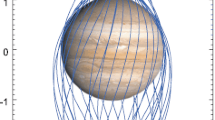Abstract
The Energetic Particles: Acceleration, Composition, and Transport (EPACT) investigation is designed to make comprehensive observations of solar, interplanetary, and galactic particles over wide ranges of charge, mass, energy, and intensity using a combination of 8 different particle telescopes. This paper summarizes the scientific goals of EPACT and provides a detailed description of the instrument design and capabilities.
Electrons are measured from 0.2 to 10 MeV, primarily providing time markers for injections of solar particles. Hydrogen is measured from 1.4 to 120 MeV, and Helium is measured from 0.04 to 500 MeV nucl−1. The collection powers and energy ranges for heavier nuclei up to iron are ideal for observations of quiet-time populations such as particles accelerated by interplanetary shocks and the anomalous cosmic rays (thought to be accelerated at the boundary of the heliosphere). The large collection power available is also ideal for observations of3He,4He, and heavier nuclei in impulsive3He-rich solar events. There is even the possibility of observing ultra heavy nuclei (Z>30) in large solar events for the first time. Finally, there is a telescope designed to measure isotopes from He (3.4–55 MeV nucl−1) to Fe (12–230 MeV nucl−1), which is intended for solar particles, the anomalous cosmic rays and galactic cosmic rays. The overall capabilities of EPACT provide scientifically interesting measurements over all phases of the solar cycle. There will also be important opportunities for combined studies with other spacecraft, such as SAMPEX, Ulysses, and Voyagers 1 and 2.
Similar content being viewed by others
References
Barbier, L. M., Reames, D. V., and von Rosenvinge, T. T.: 1993,Proc. XXIII Int. Cosmic Ray Conf., Calgary 3, 222.
Miller, J. A. and Viñas, A. F.: 1993,Astrophys. J. 412, 386.
Perkins, M. A., Kristoff, J. J., Mason, G. M., and Sullivan, J. D.: 1969,Nucl. Inst. Methods 68, 149.
Reames, D. V.: 1990,Astrophys. J. Suppl. 73, 235.
Reames, D. V., Meyer, J. P., and von Rosenvinge, T. T.: 1994,Astrophys. J. Suppl. 90, 649.
Reames, D. V., Richardson, I. G., and Barbier, L. M.: 1991,Astrophys. J. Letters 382, L43
Simpson, J. A. and Garcia-Munoz, M.: 1988,Space Sci. Rev. 46, 205.
Temerin, M. and Roth, I.: 1992,Astrophys. J. 391, L105.
UTMC: 1990a, ‘UT1750AR RISC Microprocessor’, United Technologies Microelectronics Center (UTMC), Colorado Springs, Colorado, Data Sheet.
UTMC: 1990b, ‘UTD-R Gate Array Family’, United Technologies Microelectronics Center (UTMC), Colorado Springs, Colorado, Data Sheet.
von Rosenvinge, T. T., Barbier, L. M., and Reames, D. V.: 1993,Proc. XXIII Int. Cosmic Ray Conf., Calgary 3, 400.
Winkert, G.: 1992, IEEE Trans. on Nuc. Sci. 39, 789.
Author information
Authors and Affiliations
Rights and permissions
About this article
Cite this article
Von Rosenvinge, T.T., Barbier, L.M., Karsch, J. et al. The Energetic Particles: Acceleration, Composition, and Transport (EPACT) investigation on the WIND spacecraft. Space Sci Rev 71, 155–206 (1995). https://doi.org/10.1007/BF00751329
Received:
Issue Date:
DOI: https://doi.org/10.1007/BF00751329




